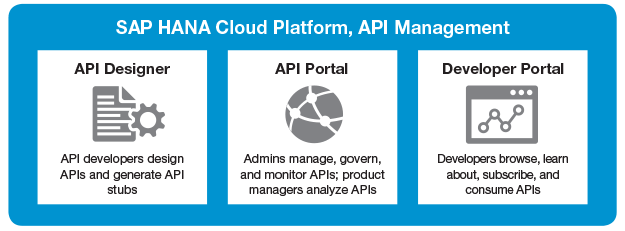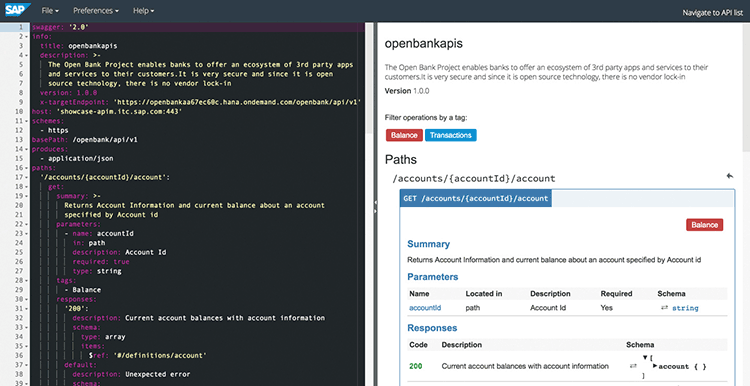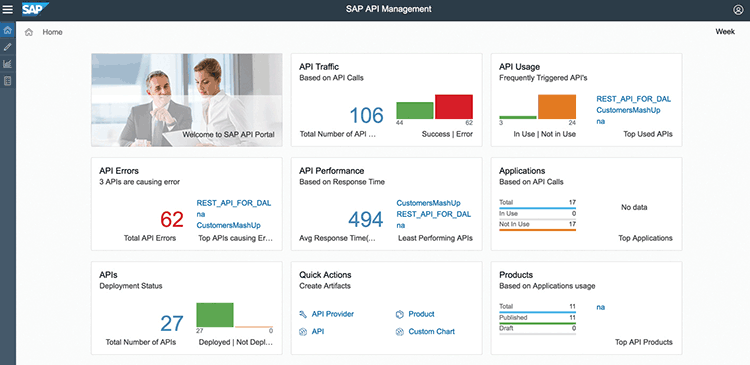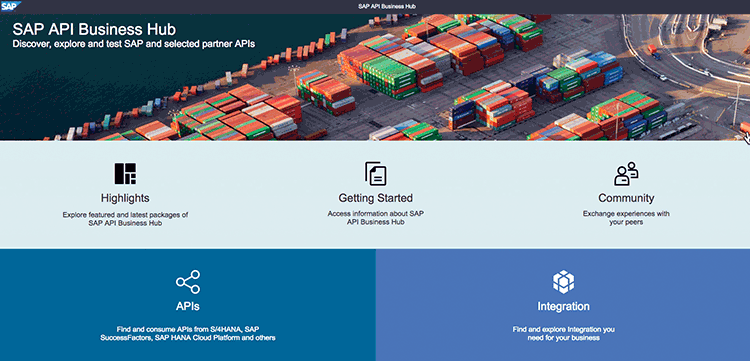Building a Digital Business with APIs
How SAP HANA Cloud Platform, API Management and SAP API Business Hub Enable Organizations in the Digital Age
A digital transformation is an opportunity to reinvent your business. Organizations such as Uber, Airbnb, Netflix, and Alibaba are disrupting established industries with no physical infrastructure — just technologies that enable digital interactions, such as mobile applications. These same technologies are available to help any enterprise, in any industry, realize the benefits of digitization.
A digital enterprise can engage customers across all touchpoints and integrate with partners, enabling superior customer experiences, seamless supplier collaboration, and new business relationships. So how is all this possible? All these digital interactions happen outside traditional IT boundaries and environments — they are facilitated by open application programming interfaces (APIs), the building blocks for innovative applications in the digital age.
This article explains the importance of APIs in modern business environments and explores the tools available from SAP that help you take advantage of APIs in your enterprise, including SAP HANA Cloud Platform, API management, a technology for managing the full life cycle of your APIs, and SAP API Business Hub, a directory of APIs developed by SAP and partners that provides out-of-the-box API content that customers and partners can use to build extensions, develop new applications, or integrate with SAP solutions.
What Are APIs and Why Are They Important?
APIs have long been a part of software development, providing interfaces that allow applications to talk to one another and exchange information. In addition to enabling application integration, APIs ease application development by providing a standardized way of connecting to various data sources, allowing developers to build innovative solutions.
APIs for Microsoft Windows development, such as Win32, have been around for decades, as has the remote procedure calls (RPC) protocol, which is used for enabling communication between systems and applications. SAP’s own APIs — including remote function calls (RFCs), BAPIs, and intermediate documents (IDocs) — have helped customers to extend and integrate with the SAP platform since the days of SAP R/3. Modern APIs are web APIs based on open protocols such as HTTP and JSON, which SAP developers can use to build applications based on mobile and SAP Fiori technology, for example, and to integrate systems using middleware.
While APIs are nothing new, the digital economy is new, and APIs are key to successfully navigating this new reality by becoming an agile, innovative digital business. With APIs, developers can quickly and easily build sophisticated, reliable user experiences — both for customers and employees. APIs enable access to a stable digital core from a rapid innovation layer in the cloud, such as SAP HANA Cloud Platform, allowing developers to bring modern consumerization trends to customers and employees, such as omni-channel interfaces that enable a consistent digital experience across various devices, from desktop, to mobile, to personal assistant devices.
In addition, APIs can play an important role when it comes to your fundamental asset in the digital age: data. IT landscapes are becoming increasingly heterogeneous with architectures that can span on-premise, cloud, or hybrid deployments, meaning that your centralized ERP database is no longer the single source of truth for your enterprise data. In a digital business, APIs can serve as the single source of truth across expanded environments. Enterprises have also realized that in a digital economy, their enterprise data can be curated and exposed via APIs for monetization and new revenue streams. For example, cleansed and curated address or geo-location information can be exposed by APIs and then monetized — used by retailers to devise targeted marketing campaigns, for example.
To fully realize the benefits of APIs, enterprises must craft a strong API strategy. While the full details of developing API strategies and programs are beyond the scope of this article, the technology you use to support these tasks will determine the success of the endeavor. Here, we look at SAP HANA Cloud Platform, API management and SAP API Business Hub to demonstrate how you can leverage these technologies to support your own API strategy.
A Toolkit for API Lifecycle Management
The cloud-based SAP HANA Cloud Platform, API management1 is a comprehensive toolkit for managing every aspect of the API life cycle, from design to development to monitoring and analytics. It provides centralized API access and management based on open standards such as REST and OData, with enterprise-grade security and seamless connectivity to new and existing applications and platforms. This centralized approach simplifies the integration of SAP and third-party applications, reducing development cost and effort, fostering innovation, and allowing companies to securely share and control their APIs.
Figure 1 provides an overview of the components of SAP HANA Cloud Platform, API management: API Designer, API Portal, and Developer Portal. Let’s take a closer look at each of these components.

API Designer
To make an API available to developers for building applications, API developers first need to create a model of that API in the API Designer (see Figure 2) using the standard OpenAPI Specification (OAS, formerly known as Swagger) format. During design, the API Designer can also generate server-side API implementation code stubs — either in Java or in Node.js — that enable remote communication between applications and can be used during API development.

When the API design has been completed and validated, the API is then developed using protocols such as SOAP, plain REST, and OData. APIs can be developed using either an outside-in approach, where APIs are developed in Java, Node.js, or ABAP (using SAP Gateway) with the express purpose of exposing them for application development, or using an inside-out approach, where existing interfaces are exposed as APIs using middleware such as SAP Process Integration, SAP Process Orchestration, or SAP HANA Cloud Integration with adapters such as REST, SOAP, and OData. Data-centric APIs can be developed on SAP HANA, based on plain REST, or using OData to expose SAP HANA data.
Once an API is designed, developed, and documented, API developers can mock up the API with sample data, and developers can start using it to build applications.
API Portal
API administrators need a way to govern APIs designed and developed for use by developers. The API Portal (see Figure 3) offers a rich set of policies to help administrators manage, orchestrate, and govern APIs. These include policies for security (based on protocols such as OAuth and SAML); traffic management (including quota and spike arrest policies); caching; and mediation (used for protocol transformations). The API Portal also includes logging capabilities to provide insight into API behavior and supports scripting with JavaScript, XSL, and Python to enable policy customization.

The API Portal also enables product managers to bundle APIs into API products and publish them in the Developer Portal for consumption by devel-opers. Product managers can then monitor and analyze API usage to better understand and grow the adoption of APIs. The API Portal provides powerful analytics and reporting capabilities that can be used to guide the evolution of your APIs.
Developer Portal
The Developer Portal (see Figure 4) is where internal, partner, or external developers can log in, browse, and test APIs that were designed in the API Designer and are governed in the API Portal. It provides developers with an environment for reading API documentation, subscribing to and getting API keys, and consuming APIs in their own applications.

This portal is an interactive and customizable environment. SAP customers can extend it or build their own version of the portal using APIs from SAP HANA Cloud Platform, API management — to integrate the portal into their existing corporate portal or to customize the portal to reflect corporate branding, for example.
Exploring APIs with SAP API Business Hub
While the Developer Portal in SAP HANA Cloud Platform, API management enables organizations to share their own APIs with their own partners and customers, the SAP and partner ecosystem contains a treasure trove of additional APIs for extending SAP applications, integrating them with other systems, and even building new applications. For example, many SAP applications — such as SAP ERP, SAP S/4HANA, and SAP HANA, as well as SAP SuccessFactors, SAP Ariba, SAP Fieldglass, and SAP Hybris solutions — offer web-based APIs that are based on REST/OData principles and exposed through embedded SAP Gateway technology.
To provide access to these APIs to SAP customers and partners, SAP created SAP API Business Hub (https://api.sap.com). Launched at SAPPHIRE NOW in 2016 as a service available with SAP HANA Cloud Platform, SAP API Business Hub is a central, online catalog of APIs developed by SAP and SAP partners that is continually updated (see Figure 5). Using this catalog, developers can search, test, and consume the services they need to build new applications, application extensions, or process integrations on SAP HANA Cloud Platform. It includes a sandbox test environment for testing APIs and also integrates with SAP Web IDE, SAP’s web-based application development environment for developing SAPUI5-based SAP Fiori applications.

SAP API Business Hub is a useful complement to the Developer Portal of SAP HANA Cloud Platform, API management — it provides access to APIs created by SAP’s own developers as well as carefully selected and screened APIs from partners, and can serve as a model for creating a robust Developer Portal in SAP HANA Cloud Platform, API management. Going forward, SAP plans to enable customers to also add APIs from SAP API Business Hub to SAP HANA Cloud Platform, API management.
Summary
APIs are critical for creating applications that excel in the digital economy. By leveraging comprehensive tools for managing and using APIs, such as SAP HANA Cloud Platform, API management and SAP API Business Hub, businesses can provide their developers with the capabilities they need to build innovative applications that will push the business forward (see the sidebar “How SAP Customers Are Using APIs” for a few examples).
Learn more about SAP HANA Cloud Platform, API management at https://go.sap.com/product/technology-platform/api-management.html and try it with a free trial of SAP HANA Cloud Platform at https://hcp.sap.com/try.html. Explore APIs from SAP and partners at https://api.sap.com.
1 An on-premise edition — SAP API Management by Apigee — is available as an SAP solution extension. [back]








